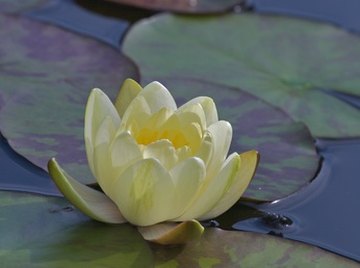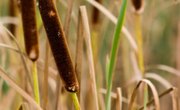
What is a water lily? Water lilies, which are also known by the names American white water-lily, fragrant water-lily, sweet-scented water-lily and beaver root, are common to calm waters of Canada and the United States. The scientific name of the plant is Nymphaea odorata, which refers to the odor, or fragrance, of the water lily flower. A perennial aquatic plant, water lilies tend to grow in quiet waters that are up to six feet deep.
Water Lily Habitat
How do lily pads grow? With leaves and flowers that float on the surface of the water, water lilies have fleshy rhizomes that anchor them to the mucky soil at the bottom of ponds or rivers. They prefer still, quiet waters such as the edges of small lakes or the backwaters of slow-moving streams. Shallow marshes, bogs and ponds are ideal for water lilies, as they usually grow in water that is only five or six feet deep.
Water lily images are easy to find, as the species is spread far and wide in the United States and Canada. Native to areas of both countries, water lilies have naturalized in many other parts of North America – in fact, the plant is now considered invasive in some of the western states of the United States.
Water lilies provide both food and habitat for other species, including insects, birds, amphibians, reptiles and mammals. Muskrats rely on the rhizomes of water lilies as a large part of their diets, and white-tailed deer, beavers and moose also feed on the foliage of water lilies in the Adirondack Mountain region of New York State.
Water Lily Flowers
The blossoming period of water lilies is short and sweet. Blooming for only three days, water lily flowers stay open only during the mornings, closing each night. With one bloom to a stem, the flowers of water lilies are about two to six inches across. Open blooms display 20 to 30 white petals, and the centers of the flowers are filled with as many as 70 yellow stamens.
The life cycle of a water lily flower is optimized for cross-pollination. On the first day a water lily flower blooms, the flower does not fully open. Instead, the flower petals spread just enough to form a cup-like shape, and the flower draws pollinators in by producing a nectar. The female reproductive structure of the flower, the stigma, is receptive to pollen only on the first day the flower opens.
On the second and third day of flowering, water lily blooms produce pollen to fertilize the blooms of other nearby plants. The flowers open wide on the second and third days to aid in the dispersal of pollen grains.
On the fourth day, water lily flowers are drawn underwater, where seeds will mature inside a globe-shaped fruit if the flower has been cross-pollinated. Seeds will then be dispersed by water currents and waterfowl. Water lilies also reproduce asexually, through the division of rhizomes, which is how they are usually propagated commercially.
Water Lily Pads
The large, round, waxy leaves of water lilies can be up to 10 inches in diameter. Green on the top and reddish-purple on the bottom, the leaves of water lilies have a v-shaped cut where the stem is attached.
The long stems of these aquatic plants connect the floating lily pads to the rhizomes, the horizontal structures that anchor the plants to the mucky bottom of the stream or pond. The leaf stalks of water lilies are unique because they are spongy, with four channels for moving oxygen from the leaves to the rhizomes of the plants. These air-filled chambers help the lily pads float.
Often planted in backyard gardens, both the flowers and pads of water lilies are attractive and useful as ornamentals.
References
About the Author
Meg Schader is a freelance writer and copyeditor. She holds a Bachelor of Science in agriculture from Cornell University and a Master of Professional Studies in environmental studies from SUNY College of Environmental Science and Forestry. Along with freelancing, she also runs a small farm with her family in Central New York.
Photo Credits
Water Lily image by Nod from Fotolia.com
